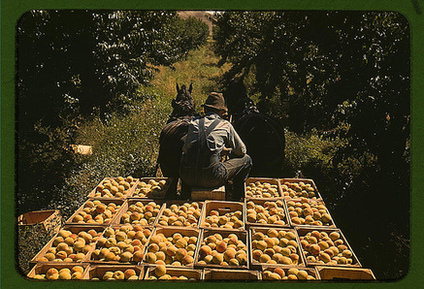
tel: 512-280-1192 Dec 23, 2011
Nursery Notes: Wishing all our customers a happy holiday season!
And thank you for your support of our nursery during the past year.
Somehow we have ended the year with what seemed impossible just
a few months back... RAIN - and lots of it. Evidently all the dances
and prayers worked....eventually. Happy Holidays Gardeners!
______________________________________________________
The Era of Flower Towers has arrived; Architects are tackling the
problems of the concrete jungle with ambitious schemes using green
technology to grow forests in the sky (from the Financial Times):
_______________________________________________________
On Central Texas Gardener (KLRU-TV): Sharon Lovejoy, author
of Toad Cottages and Shooting Stars, sparks childhood imagination
and creativity; and meet the next generation of gardeners from Casis
Elementary. Sat: noon and 4 p.m. Sun: 9 a.m. or click here:

Hauling crates of peaches from the orchard to the shipping shed,
Colo. 1940 Sept. Lee, Russell (from Flikr creative commons)
Chilling Hours for Fruit Trees
by Chris Winslow
‘Chilling Hour’ might sound more like the name of a hip-hop radio
show… but in our world of orchards and fruit tree gardening, the
meaning is quite different.
Stone fruit trees such as peaches, nectarines, plums, and cherries,
develop their flowering and vegetative buds in the summer. They go
dormant in the fall, as cooler temperatures and shorter days arrive.
Fruit trees will remain dormant until they have acquired the proper
number of ‘chilling hours’ (temperatures at 45 degrees and lower).
When they reach their chilling hour demand and the weather begins
to warm, the fruit trees will break dormancy and begin to flower,
leaf out, and set fruit.
In the Rio Grande valley (stone fruit chilling zones 6 and 7), where
the winters are mild, it is best to pick fruit trees with chilling hour
demands of 150 to 300 hours.
In north Texas (zones 1 and 2), where winters are longer and more
severe, fruit trees with high chilling hour requirements (above 800
hours), would be the best choice.
For our area, a fruit tree with chilling hour requirements in the 500
to 750 hours is ideal. Low chilling hour trees such as tropiberta and
early grande, both peaches, might bloom early and be caught in a
mid to late winter freeze, lessening its fruit set.
Here are a few favorites for our central Texas area (zones 4 and 5):
Plums
Generally plant at least two varieties to increase pollination and fruit
set. The smaller fruit varieties also do the best. Some of the tried and
true are bruce, methly, allred, burgundy, and Santa Rosa.
Peaches
Most peaches are self-fruitful, so only one is needed if you only have
a small area. Some of the best varieties for our area are junegold,
belle of Georgia (white fleshed), loring, harvester, and la feliciana.
One later blooming variety that is worth mentioning is elberta. This
750 to 800 hour August peach is a consistent producer and almost
never gets caught in a late freeze.
Cherries
Probably the only sweet cherry that has a chance for our area is Stella.
Stella is a large, black, sweet cherry that is self-fertile, and has a chilling
hour requirement of 750 hours. The problem with growing cherries is
the birds like them more than people do (hard to imagine). These trees
need to be netted if there is any hope of harvesting fruit.
Happy Holidays Gardeners!
 Visit the website: www.itsaboutthyme.com
Visit the website: www.itsaboutthyme.com Visit the nursery:11726 Manchaca Road, Austin 78748